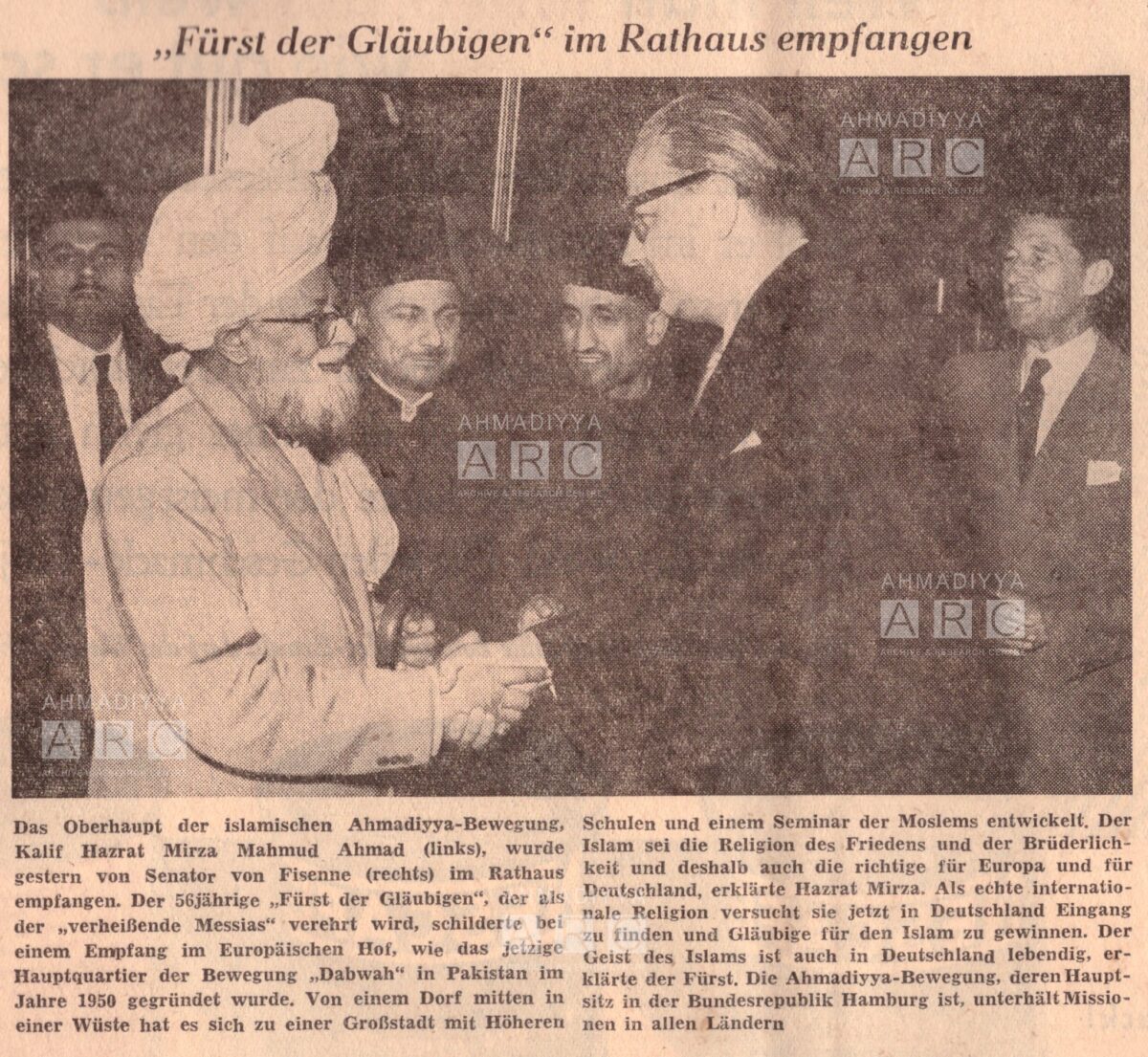Ata-ul-Haye Nasir, Ahmadiyya Archive and Research Centre
Hazrat Mirza Ghulam Ahmadas of Qadian, the Promised Messiah and Mahdi, states:
“God Almighty desires to draw all those who live in various habitations of the world, be it Europe or Asia, and who have virtuous nature, to the Unity of God and unite His servants under one Faith.” (The Will [Al-Wasiyyat], pp. 8-9)
The writings, claims and prophecies of the Promised Messiahas had reached far and wide during his life through various periodicals around the world, and this continued after his time as well.
We found several German newspapers, which served as a means to spread the message of the Promised Messiahas.
It is worth acknowledging that the newspapers might incorporate particular perspectives pertaining to Ahmadiyyat based on their own comprehension or convictions. Consequently, such interpretations should not be misconstrued as a comprehensive or accurate representation of the viewpoints or beliefs espoused by the Ahmadiyya Muslim Community.
Some examples from those newspapers are given below [translated from German]:
In 1902, a German newspaper, Dortmunder Zeitung, wrote that there were two schools of thought prevalent among the Muslims in Northern India. Firstly, the liberal one led by Sir Syed Ahmad Khan who “wanted to take all of modern science into Islam and transform it accordingly.” On the other hand, “Mirza Ghulam Ahmed[as] of Qadian, founded a new, conservative school, intended to champion the claims of Islam as the one true religion.” (Dortmunder Zeitung, 8 December 1902, p. 11)

The Deutsche Allgemeine Zeitung, in its 16 August 1923 issue, mentioned the foundation laying ceremony of the proposed Berlin Mosque [which took place on 6 August] and stated how Ahmadis were opposed by non-Ahmadi Muslims. It gave a detailed introduction of the Promised Messiahas and Khilafat-e-Ahmadiyya under the heading “Zur Ahmadia-Bewegung” – About the Ahmadiyya Movement:
“The Founder of the Ahmadiyya Movement, Mirza Ghulam Ahmad[as], of an ancient noble family of Mongolian-Persian blood, lived in Qadian (hence known as Qadiani) from 1836 to 1908, in the Punjab (North India). He was an undoubtedly strong, deeply religious, and moral personality. In the spirit and words of Jesus and grounded in Islamic principles, he preached religious and moral renewal and enhancement to his Muslim co-religionists, as well as Christians, and Hindus. The consciousness of a task assigned to him by God deepened in him around 1890, to the point that he, who worked in the spirit and in the power of Jesus, was the Jesus whose return is promised, at the same time the Mahdi awaited by the Muslims, and also a [second coming] of Krishna. He performs miracles and predicts the future. Among the eighty books and writings published by him in Urdu, Arabic and English, there are those that […] focus solely on Islamic principles, and have had a far-reaching impact. This includes his ‘[The Philosophy of the] Teachings of Islam’, which was originally written in Urdu and presented at the Great Religious Conference in Lahore in 1896. It is repeatedly printed in English, and a German translation is to be published shortly. Nevertheless, the emphasis on the divine mission of the Promised Messiah has a special effect. A follower of Ahmadiyya commits himself to the Laws of Islam, the Holy Quran and the traditions (Hadith). He acknowledges Muhammad[as] as the Seal of the Prophets. […]
“The Ahmadiyya movement has meanwhile developed robustly. The leadership continues to stay in Qadian, where the deceased [Promised Messiahas] had a first successor (Khalifa) in the person of Maulvi Noor-ud-Din[ra], and the present Khalifa Mirza Bashir-ud-Din Mahmud Ahmad[ra] succeeded him. The foremost duty of an Ahmadi is the propagation of Islam. The Master’s [Promised Messiahas] prophecies include that the majority of the people of Europe will convert to Islam and believe in Ahmad[as], and that eventually the Ahmadiyya Movement will prevail all over the world. So the religious ardour of the Master lives on in a far-reaching missionary activity in West Africa, America, London, and now Berlin. The costs for the mosque that is about to be built here in Berlin are entirely borne by Ahmadi women who sacrificed their money and jewellery.” (Deutsche Allgemeine Zeitung, 16 August 1923, p. 2)
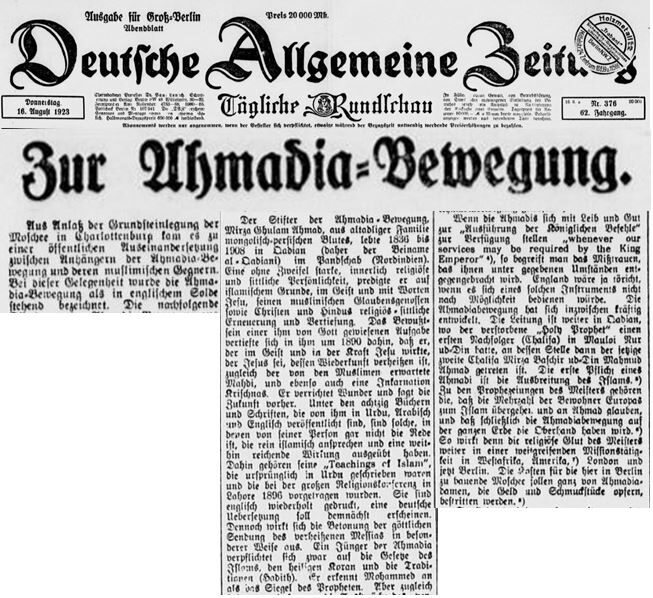
The Neue Mannheimer Zeitung published an article by Ernst von Wolzogen, titled “Was man vom Islam wissen sollte” – What you should know about Islam. Mentioning the Promised Messiahas, he states:
“Among us in Europe, it is hardly known that just recently the whole Islamic world was vividly moved by the appearance of such a successor of the Prophet [Muhammadsa] who claimed to possess the power of Divine revelation. Mirza Ghulam Ahmad[as] is the name of the man recognised by many Muslims as such a chosen one. About 70 English miles from Lahore in [British] India lies the town of Qadian. Mirza Ghulam Ahmad[as] was born there in 1839 [sic. 1835], to a noble family who had emigrated from Persia in the sixteenth century. […] At a young age, he acquired a quite unusual mastery of Arabic and Persian, as well as Western philosophical and religious literature. Although he obeyed his father by accepting an office in the government at the age of 25 and administering it dutifully, he used all his free time to continue his studies and religious immersion in complete isolation from the world. He had already earned a respected name as a philosophical writer and was already considered an authority on religious matters in the narrower circles when he stirred up all of spiritual India with an appeal, issued in all the newspapers, offering a prize of 10,000 rupees for those of other faiths who could present at least one-fifth as many convincing arguments for the truth of their faith as he could for Islam – or if that fails, they should at least be able to refute his, Mirza’s arguments. To date, no one has won the award. Moreover, the Christian churches of India have strictly forbidden their clergy to engage in religious discussions with Ahmad[as] or his followers. Since this man could not be attacked with intellectual weapons, attempts were made to ostracise him both socially and civically. His opponent, a Mr. [Henry Martyn] Clark, sued him for incitement to murder. In court, Ahmad’s[as] defence attorney wanted to bring down Clark by presenting him with a highly perilous question that, if he answered yes, would make Clark’s witnesses liars, if he answered no, he would make it impossible and ridiculous for himself. Then Ahmad[as] stood up and calmly and earnestly forbade his defence attorney’s question. This knightly magnanimity towards a mortal enemy […] disarmed all his opponents, and as the English court had to acquit him, so the heads of the Islamic sects could not have anything against him. When he passed away in 1908, the very conservative newspaper Vakil in Amritsar wrote: ‘The man who for 30 years spelled a storm and a quake in the religious world, whose two fists resembled two electric batteries, and fingers entwined with the wires of a revolution, he, Mirza Ghulam Ahmad[as] of Qadian, has passed away.’
“It would require an entire book to make the significance of this Prophet clear to Christian Europeans. Most importantly, he swept away innumerable kinds of superstitions that had accumulated over the centuries, freed the common people from the tyranny of the Maulvis, the ignorant, lowly clerics, and stirred up Islam for propaganda among the followers of other religions. Since then, we have had an Islamic mission in Europe.” (Neue Mannheimer Zeitung, 25 August 1928, p. 8)
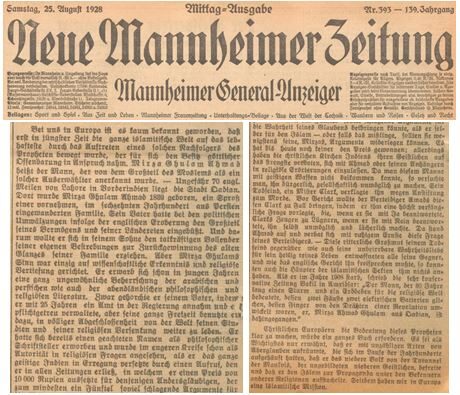
The Auer Tageblatt: Anzeiger für das Erzgebirge wrote:
“In Europe, Mirza Ghulam Ahmed[as] began the missionary activities for Mohammedanism [sic., Islam] about thirty years ago. Mosques sprang up in Paris, London, Gent, Heidelberg, and Berlin. […] The London headquarters of Mohammedanism reports that they have won over a thousand ‘enlightened’ Englishmen.” (Auer Tageblatt: Anzeiger für das Erzgebirge, 22 September 1929, p. 10)
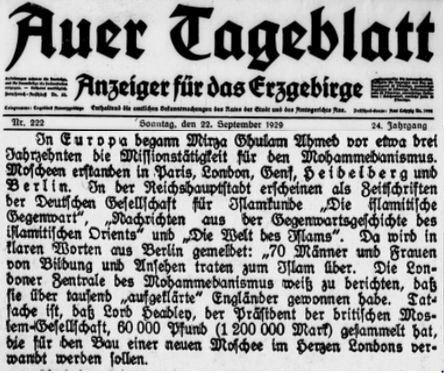
The Kölnische Zeitung stated:
“Yes, it is the Ahmadiyya Movement, a reformist sect, which today already has 20 million followers and spread in Japan, India, Africa, and America, and even has a community in London and Berlin. If you follow the trail, you always find the same thing: the crisis of all religions and the attempts at reformation. While the churches in Europe cannot manage to reform themselves on their own, Islam is far ahead of us. The Wahhabi movement comes from Arabia, and the Ahmadiyya movement comes from India. They proceed purposefully and have progressed so far that they have taken up regular missionary work.” (Kölnische Zeitung, 25 February 1937, p. 1)
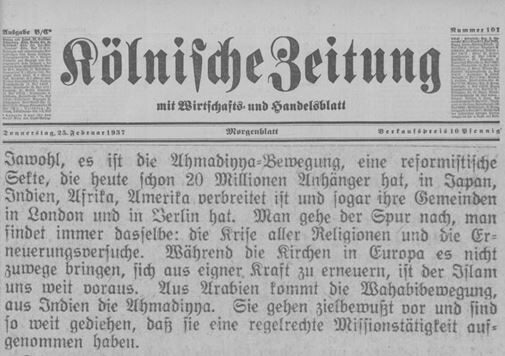
The Schwerter Zeitung wrote under the heading “Islamische Europa-Mission will in Hamburg Moschee bauen” – Islamic European Mission desires to build a mosque in Hamburg:
“Hamburg is also to receive a mosque, although the building work will still be a long time coming, explained Abdul Latif, the only European missionary of the Islamic Ahmadiyya Movement. Abdul Latif, who has been living in Europe for five years now and has been in Hamburg since January 20, wants to make regular lecture trips to Frankfurt, Bonn, Düsseldorf, Berlin, and other locations. There is already a mosque in London. In Hamburg, there was initially a small community of spiritual followers of Islam. The Mohammedans [sic., Muslims] believe that Islam will find great understanding in Europe in the future, now that active Islamic communities have been established in many European countries and in America.” (Schwerter Zeitung, 1 March 1950, p. 6)
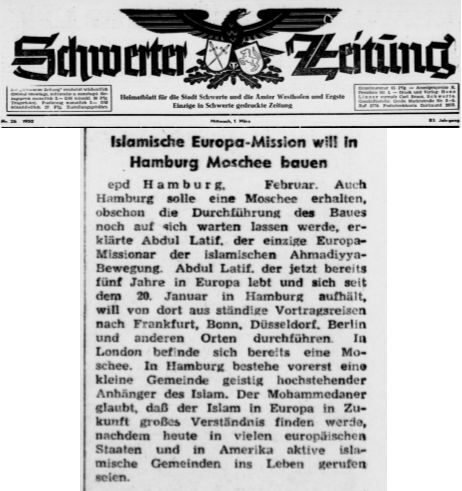
In 1955, Hamburger Anzeiger published a photo of Hazrat Musleh-e-Maudra and wrote:
“‘Prince of the Faithful’ received at Town Hall
“The head of the Islamic Ahmadiyya Movement, Caliph Hazrat Mirza Mahmud Ahmad[ra] (left), was received by Senator von Fisenne (right) at the Town Hall yesterday. The 66-year-old ‘Prince of the Faithful’, revered as the ‘Promised Reformer’, described at a reception in the Europäischen Hof how the current headquarters of the movement ‘Rabwah’ in Pakistan was founded in 1950 [sic., 1948]. From a village in the middle of a desert, it has developed into a large city with secondary schools and a seminary for Muslims. Islam is the religion of peace and brotherhood and therefore also the right one for Europe and for Germany, Hazrat Mirza[ra] explained. As a true international religion, it is now trying to find its way into Germany and win believers for Islam. The spirit of Islam is also alive in Germany, the Prince explained. The Ahmadiyya Movement, whose headquarters in the Federal Republic is in Hamburg, maintains missions in all countries.” (Hamburger Anzeiger, 28 June 1955, p. 4)
